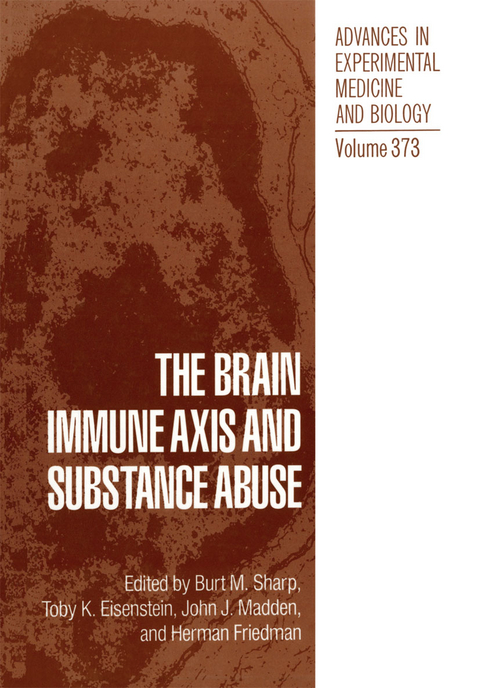
The Brain Immune Axis and Substance Abuse
Springer-Verlag New York Inc.
978-1-4613-5801-5 (ISBN)
This volume represents the proceedings of the 2nd annual symposium on the Brain Immune Axis and Substance Abuse held at the Breakers Hotel in Palm Beach, FL in June 1994. The history of productive studies concerning the relationship between the nervous and the immune systems is relatively recent. Studies on the effects of drugs of abuse on the immune system and on infections among individuals who abuse drugs are also of recent vintage. Only in the last decade have investigators begun to describe the role of drugs of abuse and their endogenous counterparts on the brain-immune axis. Thus, the involvement of the neuroendocrine system in the interactions of drugs of abuse and the immune system has only recently been appreciated. In addition, it has been recognized that direct neural inputs impact immune function. Given the complexity of these interactions, characterization of biologically significant phenomena and elucidation of their mechanisms of action often requires a multidisciplinary approach. This meeting, on which the chapters in this book are based, brought together scientists from an array of biomedical disciplines whose work is focused on the effects of drugs of abuse on the neuro-endocrine immune axis. The meeting was unique in focusing on the brain-immune axis from the viewpoint of drugs of abuse rather than either immunity itself or the brain itself. Presentations addressed the direct effects of drugs of abuse on various components of the immune system, as well as those mediated indirectly by the central nervous system and the neuroendocrine system.
1. Introduction: The Brain-Immune Axis: Role of Opiates and Other Substances of Abuse, the Hypothalmic-Pituitary-Adrenal Axis and Behavior.- 2. Detection of ?-Opioid Receptor mRNA in Immature T Cells.- 3. Identification of Opioid Receptors in the Immune System Using a Novel Combination of Selective Opioid Ligands and Indirect Phycoerythrin Immunofluorescence.- 4. Kappa Opioid Receptors on Three Related Thymoma Cell Lines: Differences in Receptor-Effector Coupling.- 5. Delta Opioid Agonists Inhibit Proliferation of Highly Purified Murine CD4+ and CD8+ T-Cells.- 6. Mitogenic Activation of Human T Lymphocytes Induces a High Affinity Morphine Binding Site.- 7. Morphine-Induced Suppression of Thymocyte Proliferation Is Mediated by Inhibition of I1-2 Synthesis.- 8. Active ?-Endorphin Metabolites Generated by T-Cell Ectopeptidases.- 9. The Cellular Basis for Opioid-Induced Immunosuppression.- 10. Endogenous Opioid Peptides Suppress Cytokine-Mediated Upregulation of HIV-1 Expression in the Chronically Infected Promonocyte Clone U1.- 11. Relevance of Opioid Bimodality to Tolerance/Dependence Formation: From Transmitter Release to Second Messenger Formation.- 12. Agonist Induced Constitutive Receptor Activation As a Novel Regulatory Mechanism: ? Receptor Regulation.- 13. Expression of Cannabinoid Receptor mRNA in Murine and Human Leukocytes.- 14. Cannabinoid Stimulation of Arachidonate Metabolism in Human Peripheral Blood Mononuclear Leukocytes.- 15. Marijuana, Receptors and Immunomodulation.- 16. Mouse Strain Differences in in vivo and in vitro Immunosuppressive Effects of Opioids.- 17. The Clastogenicity of Morphine Sulfate in vivo.- 18. Cellular Mechanisms Involved in Morphine-Mediated Suppression of CTL Activity.- 19. Evidence for the Involvement of Macrophage-DerivedNitric Oxide in the Immunomodulatory Effect of Morphine and Aversive Pavlovian Conditioning.- 20. Mechanisms Whereby Macrophage-Derived Nitric Oxide Is Involved in the Immunomodulatory Effects of Morphine.- 21. Effects of Central Administration of Morphine on Immune Status in Lewis and Wistar Rats.- 22. Morphine Alteration of Histamine Release in vivo.- 23. Effect of Chronic Morphine Treatment on Immune Responses to Keyhole Limpet Hemocyanin in Swine.- 24. SIV Mutations Detected in Morphine-Treated Macaca mulatta Following SIVmac239 Infection.- 25. Adjuvant Effects on Morphine-Induced Suppression of Immune Responses to MN rgp120/HIV-1 in Mice.- 26. Possible Mechanisms of Immunotoxicity Following in vivo Exposure to the Inhalant, Isobutyl Nitrite.- 27. Role of Immune Processes in Peripheral Opioid Analgesia.- 28. Chronic Treatment with Morphine and Ethanol, but Not Cocaine, Attenuates I1-1? Activation of FOS Expression in the Rat Hypothalamic Paraventricular Nucleus.- 29. Effects of r-Hu-Interferon-?2A in the Brain.- 30. Quantification of Macrophage-Derived Substance P Receptor mRNA Using Competitive Polymerase Chain Reaction.- 31. HIV-1 Heterogeneity and Cytokines: Neuropathogenesis.
| Reihe/Serie | Advances in Experimental Medicine and Biology ; 373 |
|---|---|
| Zusatzinfo | IX, 245 p. |
| Verlagsort | New York, NY |
| Sprache | englisch |
| Maße | 170 x 244 mm |
| Themenwelt | Medizinische Fachgebiete ► Chirurgie ► Neurochirurgie |
| Medizin / Pharmazie ► Medizinische Fachgebiete ► Neurologie | |
| Medizin / Pharmazie ► Medizinische Fachgebiete ► Pharmakologie / Pharmakotherapie | |
| Studium ► Querschnittsbereiche ► Infektiologie / Immunologie | |
| ISBN-10 | 1-4613-5801-9 / 1461358019 |
| ISBN-13 | 978-1-4613-5801-5 / 9781461358015 |
| Zustand | Neuware |
| Informationen gemäß Produktsicherheitsverordnung (GPSR) | |
| Haben Sie eine Frage zum Produkt? |
aus dem Bereich


